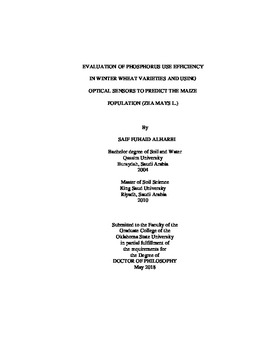| dc.contributor.advisor | Arnall, D. Brian | |
| dc.contributor.author | Alharbi, Saif Fuhaid | |
| dc.date.accessioned | 2019-03-25T21:59:36Z | |
| dc.date.available | 2019-03-25T21:59:36Z | |
| dc.date.issued | 2018-05 | |
| dc.identifier.uri | https://hdl.handle.net/11244/317779 | |
| dc.description.abstract | This dissertation includes two topics; 1) evaluation of P use efficiency in winter wheat varieties. 2) using optical sensors to predict the maize population. The objective of the first topic was to (i) simulate a soil with insoluble forms of phosphorus and to evaluate seventeen winter wheat varieties for P uptake and utilization efficiency based on the total mass of P present in the soil; (ii) screen seven wheat varieties for P use efficiency in filed experiments (iii) predict the possibility of using the normalized-difference vegetative index (NDVI) for determining P limiting conditions. For P use efficiency, several studies were conducted in the growth chamber and filed experiments. The results of greenhouse studies suggested that Gallagher and Endurance were the most efficient varieties for both P uptake efficiency and P utilization efficiency. Also, The Ok11755W was the most P utilization efficient while OK10430-2 was the most P uptake efficient. Otherwise, the Ruby Lee was among the less efficient varieties either to uptake or utilize P under greenhouse conditions. Under experimental field conditions, Duster and Endurance were found to be more efficient in extracting or utilizing more P while Ruby Lee was found to be less efficient. NDVI was also possible to estimate the P deficiency due to a strong correlation between the NDVI and yield prediction under low P conditions; this observation may be used as an indicator for P recommendation. The objective of the second topic was to identify whether there is a correlation between normalized difference vegetation index (NDVI), the Coefficient of variation (CV), and the maize population. For using optical sensors, data was collected from 76 plots located at the Agronomy Research Station (EFAW) near Stillwater, OK, and the Lake Carl Blackwell Research Station (LCB) near Bray, OK. Finding and conclusion of this study suggested that since NDVI and CV were correlated to plant population, the growth stage V4 would be the appropriate stage to predict the plant population and biomass estimation, which could be useful for producers for making replant decisions and precise estimations of replanting rates. | |
| dc.format | application/pdf | |
| dc.language | en_US | |
| dc.rights | Copyright is held by the author who has granted the Oklahoma State University Library the non-exclusive right to share this material in its institutional repository. Contact Digital Library Services at lib-dls@okstate.edu or 405-744-9161 for the permission policy on the use, reproduction or distribution of this material. | |
| dc.title | Evaluation of phosphorus use efficiency in winter wheat varieties and using optical sensors to predict the maize population (Zea mays L.) | |
| dc.contributor.committeeMember | Raun, William | |
| dc.contributor.committeeMember | Zhang, Hailin | |
| dc.contributor.committeeMember | Weckler, Paul | |
| osu.filename | Alharbi_okstate_0664D_15690.pdf | |
| osu.accesstype | Open Access | |
| dc.type.genre | Dissertation | |
| dc.type.material | Text | |
| thesis.degree.discipline | Soil Science | |
| thesis.degree.grantor | Oklahoma State University | |
